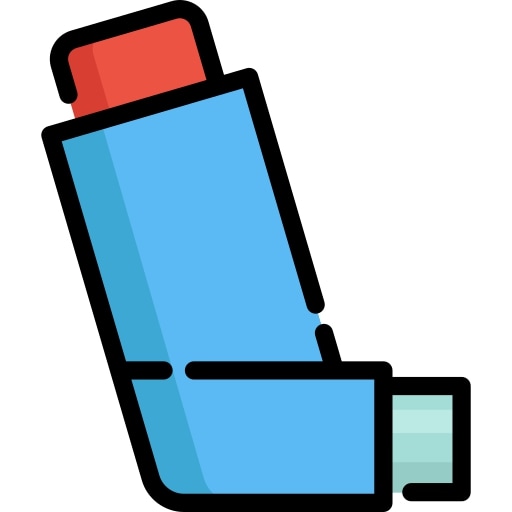SALBUTAMOL sulfate, eq. 100mcg base/puff, 200 puffs, aerosol
Valid Article
SALBUTAMOL aerosol
Therapeutic Action
Inhaled short-acting beta2 agonist (SABA) bronchodilator
After inhalation, it causes rapid bronchodilation within minutes and lasting for 4-6 hours.
Indications
Symptomatic treatment of asthma attack
For severe acute asthma attacks, prefer nebulised salbutamol given through a nebuliser.
Instructions for use
Suspension or solution in a Pressurised Metered-Dose Inhaler (MDI): a small canister containing a mixture of medicine and a pressurised propellant. The pressure from the propellant delivers the medicine when the canister is pushed down into the boot/actuator.
Method of administration:
- Shake the inhaler and ensure that the liquid can be heard moving inside. Remove the mouthpiece cover.
- Inhale fully, then exhale as completely as possible.
- Place the lips firmly around the mouthpiece.
- Start to inhale with a long, slow breath and continue to breath deeply while activating the inhaler (puff).
- Remove the inhaler, close the lips, and hold the breath for 10 seconds, or as long as is comfortable.
- Exhale slowly, wait a few seconds, shake the inhaler again, and repeat for the next puff, if needed.
Manufacturers may express the content per puff as either:
- in metered dose: the quantity of medicine in the device metering chamber, excluding the valve
- in delivered dose: the quantity of medicine delivered to the user, excluding the mouthpiece.
- Always refer to the product leaflet.
The inhalers generally supplied by MSF are pressurised metered-dose inhalers (MDI). Refer to the information leaflet for appropriate instructions for use, according to the inhaler model.
The pressurised metered-dose inhalers are CFC free. Chlorofluorocarbons (CFCs) are harmful to the ozone layer. Instead these inhalers use HFA (hydrofluoroalkane) propellants. which are a more effective and environmentally friendly alternative.
Precautions for Use
In children, use an inhalation chamber/spacer with or without a mask (depending on the child's age) with every administration of a pressurised metered-dose inhaler.
In patients who have difficulty coordinating the actuation on the metered-dose inhaler and inhalation (e.g elderly patients), use an inhalation chamber/spacer to facilitate administration and improve the effectiveness of the product.
Only use the mouthpiece supplied with the inhaler. Do not substitute it with any other mouthpiece.
Transport Dangerous Goods
UN transport code:
- UN 1950 - Aerosols, non-flammable (each not exceeding 1 L capacity)
- Transport Class 2.2 - Non-flammable, non-toxic gases
Transport is only regulated for large quantities of aerosols.
Storage
- Below 25°C ‐ Protect from sunlight
- Used aerosols: do not pierce or incinerate. Empty any residual gas before disposal. Dispose of by burying.


![[KMEDMSUP04A] (supplementary unit 2018) MODULE MEDICINES](/web/image/product.template/572560/image_256/%5BKMEDMSUP04A%5D%20%28supplementary%20unit%202018%29%20MODULE%20MEDICINES?unique=c3a8dd3)
![[KMEDMSUP04N] (supplementary unit 2018) MODULE NCD](/web/image/product.template/572577/image_256/%5BKMEDMSUP04N%5D%20%28supplementary%20unit%202018%29%20MODULE%20NCD?unique=69544eb)
![[KMEDMHWM33A] (mod ward) ORAL MEDICINES 2021](/web/image/product.template/574422/image_256/%5BKMEDMHWM33A%5D%20%28mod%20ward%29%20ORAL%20MEDICINES%202021?unique=4d33748)
![[KMEDMNUTI36D] (module nut. inpatient) MEDICINES, RTR 2021](/web/image/product.template/575124/image_256/%5BKMEDMNUTI36D%5D%20%28module%20nut.%20inpatient%29%20MEDICINES%2C%20RTR%202021?unique=fcb1599)
![[KMEDMHOM21A] (mod OT Room) INJECTABLE & ORAL MEDICINES 2021](/web/image/product.template/574471/image_256/%5BKMEDMHOM21A%5D%20%28mod%20OT%20Room%29%20INJECTABLE%20%26%20ORAL%20MEDICINES%202021?unique=696984e)
![[KMEDMHCM23A] (mod OPD) ORAL MEDICINES 2021](/web/image/product.template/574438/image_256/%5BKMEDMHCM23A%5D%20%28mod%20OPD%29%20ORAL%20MEDICINES%202021?unique=df720f2)
![[KMEDMEBO01D] (module VHF isolation) MEDICINES RTR](/web/image/product.template/571784/image_256/%5BKMEDMEBO01D%5D%20%28module%20VHF%20isolation%29%20MEDICINES%20RTR?unique=77cac43)
![[KMEDMHIM23A] (mod ICU) ORAL MEDICINES 2021](/web/image/product.template/574423/image_256/%5BKMEDMHIM23A%5D%20%28mod%20ICU%29%20ORAL%20MEDICINES%202021?unique=8b86b16)
![[KMEDMHEM33A] (mod emergency) ORAL MEDICINES 2021](/web/image/product.template/574354/image_256/%5BKMEDMHEM33A%5D%20%28mod%20emergency%29%20ORAL%20MEDICINES%202021?unique=17d7002)
![[KMEDMHAM23A] (mod AMP) ORAL MEDICINES 2021](/web/image/product.template/574352/image_256/%5BKMEDMHAM23A%5D%20%28mod%20AMP%29%20ORAL%20MEDICINES%202021?unique=bc5efbf)
![[KMEDMSUP05N] (IEHK 2024 suppl. module) SUPPLEMENTARY NCD UNIT](/web/image/product.template/583187/image_256/%5BKMEDMSUP05N%5D%20%28IEHK%202024%20suppl.%20module%29%20SUPPLEMENTARY%20NCD%20UNIT?unique=22bb047)
![[KMEDKFAI5RS] MOBILE MEDICAL BAG KIT, rucksack](/web/image/product.template/572106/image_256/%5BKMEDKFAI5RS%5D%20MOBILE%20MEDICAL%20BAG%20KIT%2C%20rucksack?unique=32c3b2b)
![[DORASALB2N2] SALBUTAMOL, 2mg/ml, 2.5ml, sol. for nebulizer, monodose](/web/image/product.template/573287/image_256/%5BDORASALB2N2%5D%20SALBUTAMOL%2C%202mg-ml%2C%202.5ml%2C%20sol.%20for%20nebulizer%2C%20monodose?unique=daf9f42)
![[SMSUSPAC4M-] SPACER, single patient, medium mask](/web/image/product.template/569846/image_256/%5BSMSUSPAC4M-%5D%20SPACER%2C%20single%20patient%2C%20medium%20mask?unique=2703dc8)
![[SMSUSPAC4S-] SPACER, single patient, small mask](/web/image/product.template/569849/image_256/%5BSMSUSPAC4S-%5D%20SPACER%2C%20single%20patient%2C%20small%20mask?unique=6730c8d)